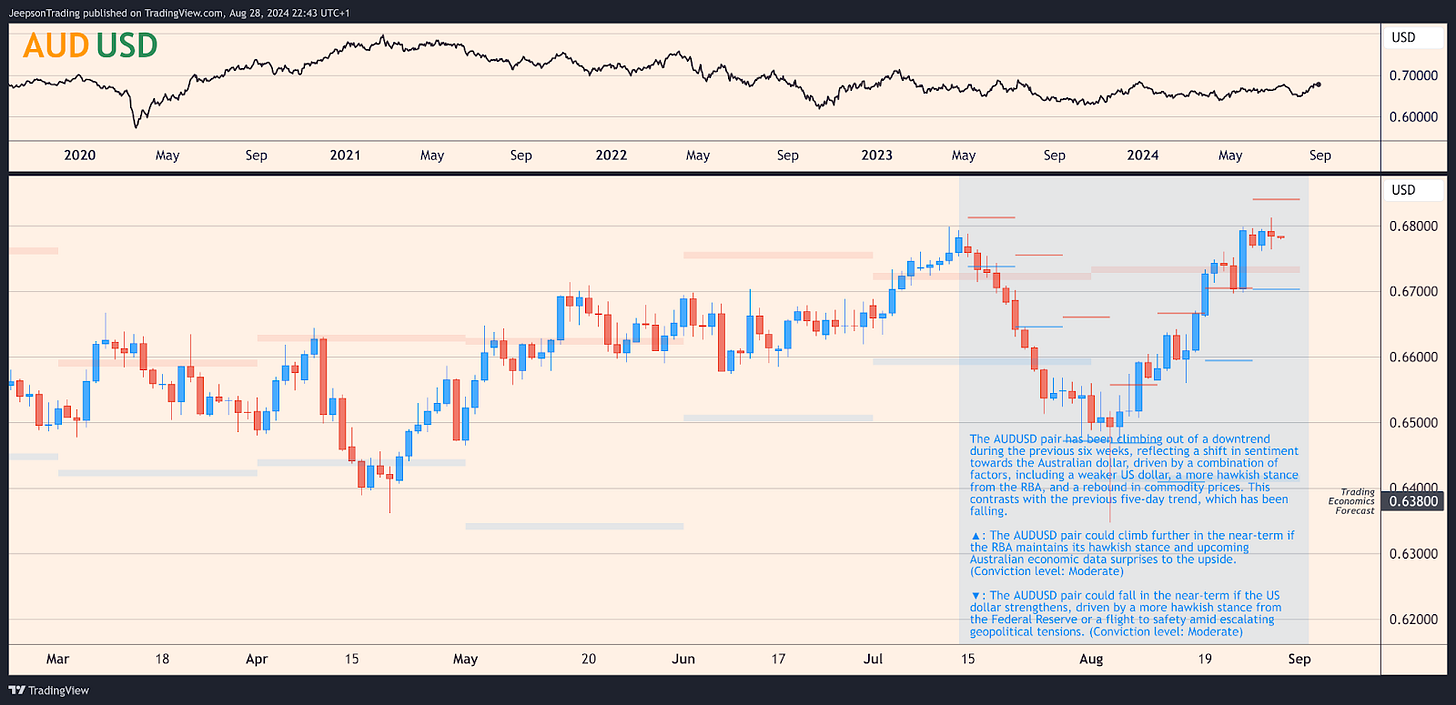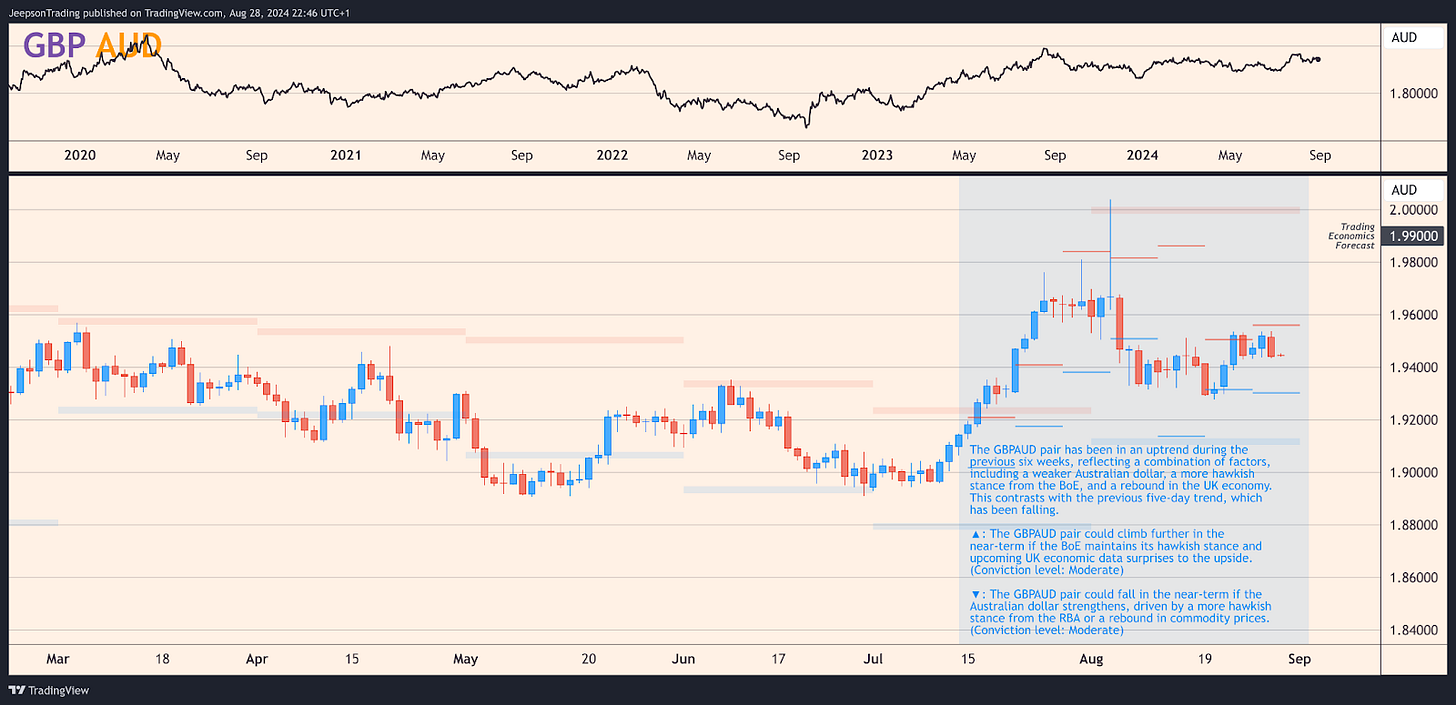The Forex Markets Today
Thursday, August 29, Week 35
This report focuses on four key currency pairs: AUDUSD, USDCAD, EURUSD, and GBPAUD. These pairs have been selected due to their sensitivity to the prevailing market themes of monetary policy divergence, global growth concerns, and geopolitical risks. The report delves into the economic fundamentals, central bank policies, geopolitical developments, technical analysis, and market sentiment surrounding each pair, providing a comprehensive outlook for the near-term.
The report examines the recent price action and trends for each pair, considering both the short-term (six-week) and near-term (five-day) perspectives. It also identifies key economic events and themes that could influence the direction of these pairs in the coming days and weeks.
Market traders are currently grappling with several key themes:
The Federal Reserve's potential shift towards a more dovish stance, as hinted at by Chair Powell's recent speech at Jackson Hole.
The unexpected contraction of the German economy in Q2 2024, raising concerns about the strength of the Euro-Area recovery.
The escalating conflict between Israel and Iran-backed militant groups, adding to geopolitical uncertainty and potentially impacting oil prices and global risk sentiment.
To provide clarity and context, this report utilises specific timeframes for analysis:
Near-term: A five-day outlook.
Short-term: A six-week outlook.
Mid-term: A six-month outlook.
Long-term: A five-year outlook.
AUDUSD
The AUDUSD pair is popular among carry traders seeking to capitalise on interest rate differentials between Australia and the United States. Liquidity in the pair is typically driven by macroeconomic data releases, central bank announcements, and shifts in global risk sentiment. The AUDUSD pair is positively correlated with commodity prices, particularly gold and iron ore, reflecting Australia's status as a major commodity exporter.
Navigating the Aussie's Crosscurrents
The AUDUSD pair has been falling during the previous five days, contrasting with the six-week trend, which has been climbing out of a downtrend. This suggests a potential shift in sentiment towards the US dollar, driven by a combination of factors, including a stronger US dollar, a more hawkish stance from the Federal Reserve, and concerns about the global economic outlook.
▲: The AUDUSD pair could climb further in the near-term if the RBA maintains its hawkish stance and upcoming Australian economic data surprises to the upside, particularly the July employment report and the August CPI inflation data. (Conviction level: Moderate)
▼: The AUDUSD pair could fall in the near-term if the US dollar strengthens, driven by a more hawkish stance from the Federal Reserve or a flight to safety amid escalating geopolitical tensions. (Conviction level: Moderate)
USDCAD
The USDCAD pair is heavily influenced by the price of oil, reflecting Canada's status as a major oil exporter. Liquidity in the pair is typically driven by macroeconomic data releases, central bank announcements, and fluctuations in oil prices. The USDCAD pair is also sensitive to the performance of the US stock market, as Canada's economy is closely tied to that of the United States.
Navigating the Loonie's Labyrinth
The USDCAD pair has been falling during the previous six weeks, forming a downtrend. This reflects a combination of factors, including a weaker US dollar, a more dovish stance from the Bank of Canada (BoC), and a rebound in oil prices. This aligns with the previous five-day trend, which has also been falling.
▲: The USDCAD pair could climb in the near-term if oil prices fall sharply, driven by a slowdown in global economic growth or an easing of geopolitical tensions in the Middle East. (Conviction level: Low)
▼: The USDCAD pair could fall further in the near-term if the BoC maintains its dovish stance and upcoming Canadian economic data surprises to the downside, particularly the August CPI inflation data and the July GDP growth rate. (Conviction level: Moderate)
EURUSD
The EURUSD pair is heavily influenced by the monetary policy divergence between the European Central Bank (ECB) and the Federal Reserve, as well as the economic performance of the Euro-Area. Liquidity in the pair is typically driven by macroeconomic data releases, central bank announcements, and shifts in global risk sentiment. The EURUSD pair is also sensitive to geopolitical developments in Europe, particularly the ongoing conflict in Ukraine.
Navigating the Euro's Labyrinth
The EURUSD pair has been falling during the previous five days, contrasting with the six-week trend, which has been in an uptrend. This suggests a potential shift in sentiment towards the US dollar, driven by a combination of factors, including a more hawkish stance from the Federal Reserve, concerns about the strength of the Euro-Area recovery, and a flight to safety amid escalating geopolitical tensions.
▲: The EURUSD pair could climb further in the near-term if the Federal Reserve maintains its hawkish stance and upcoming US economic data surprises to the upside, particularly the August jobs report and the July PCE inflation data. (Conviction level: Moderate)
▼: The EURUSD pair could fall in the near-term if the ECB adopts a more dovish stance, driven by concerns about the strength of the Euro-Area recovery or a further escalation of the conflict in Ukraine. (Conviction level: Moderate)
GBPAUD
The GBPAUD pair is influenced by the economic performance of both the UK and Australia, as well as the monetary policy divergence between the Bank of England (BoE) and the RBA. Liquidity in the pair is typically driven by macroeconomic data releases, central bank announcements, and shifts in global risk sentiment. The GBPAUD pair is also sensitive to commodity prices, as Australia is a major commodity exporter.
Navigating the Sterling's Path
The GBPAUD pair has been falling during the previous five days, contrasting with the six-week trend, which has been in an uptrend. This suggests a potential shift in sentiment towards the Australian dollar, driven by a combination of factors, including a weaker British pound, a more hawkish stance from the RBA, and a rebound in commodity prices.
▲: The GBPAUD pair could climb further in the near-term if the BoE maintains its hawkish stance and upcoming UK economic data surprises to the upside, particularly the July GDP growth rate and the August CPI inflation data. (Conviction level: Moderate)
▼: The GBPAUD pair could fall in the near-term if the Australian dollar strengthens, driven by a more hawkish stance from the RBA or a rebound in commodity prices. (Conviction level: Moderate)
Conclusion
This report has provided a comprehensive analysis of four key currency pairs: AUDUSD, USDCAD, EURUSD, and GBPAUD. Each pair is influenced by a unique set of economic fundamentals, central bank policies, geopolitical developments, and market sentiment. Understanding these drivers is crucial for forex traders seeking to make informed trading decisions.
The report has highlighted the potential for both upside and downside risks for each pair, emphasising the importance of closely monitoring upcoming economic data releases, central bank announcements, and geopolitical developments. The report has also provided insights into the technical analysis and market sentiment surrounding each pair, offering a holistic view of the factors shaping their near-term outlook.
Key Takeaways for Forex Traders
The Federal Reserve's potential shift towards a more dovish stance could weigh on the US dollar, supporting the AUDUSD and EURUSD pairs.
The unexpected contraction of the German economy in Q2 2024 raises concerns about the strength of the Euro-Area recovery, potentially weighing on the euro and supporting the EURUSD pair.
The escalating conflict between Israel and Iran-backed militant groups adds to geopolitical uncertainty, potentially impacting oil prices and global risk sentiment, which could influence the USDCAD and GBPAUD pairs.
The RBA's hawkish stance and the potential for further interest rate hikes could support the Australian dollar.
The BoE's recent rate cut and the potential for further easing could weigh on the British pound.
Sources
Australian Bureau of Statistics (ABS)
Reserve Bank of Australia (RBA)
Bank of Canada (BoC)
Statistics Canada
European Central Bank (ECB)
Eurostat
Federal Statistical Office, Germany
INSEE, France
Bank of England (BoE)
Office for National Statistics (ONS)
Trading Economics
Bloomberg
Reuters
Stratfor Worldview
Newsquawk






